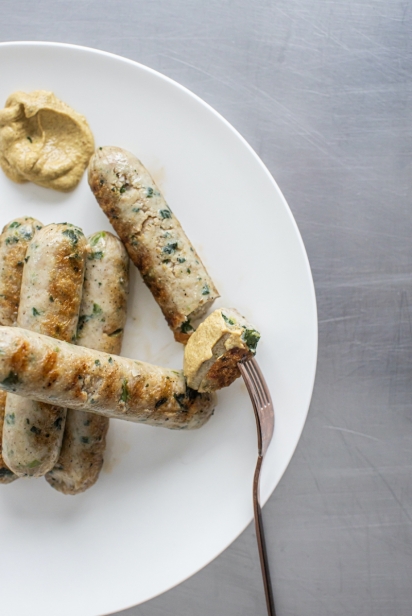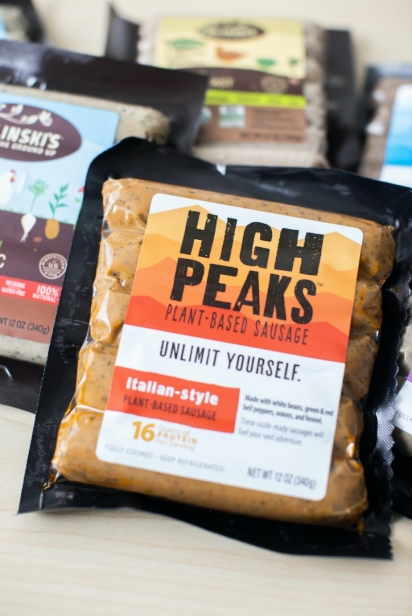See How Bilinkski's Makes the Sausage
There’s a reason no one wants to see how the sausage gets made (and why sausage factories typically don’t let reporters and photographers inside to peer around and ask rude questions).
Making sausage is generally thought of as a grisly business, the stuff of squeamish nightmares. Technically, it’s a cylindrical product, generally comprised of bits of ground meat and spice, and squished into a casing that is traditionally made from intestines. But there are many grossout by-products consumers are biting into along with the pork ’n’ parsley, such as chicken skin, edible offal like an animal’s liver, heart and stomach, not to mention edible fillers, often industrially produced, like corn syrup, water, soy, silicon dioxide, food coloring, maltodextrin.
Mmm, who fancies a banger?
Sausages aren’t going anywhere, though, because no one wants them to. They were mentioned in the Odyssey (Homer jotted that baby down 2,700 years ago), and 89% of Americans eat them, according to a Harris Poll (NB: It was commissioned by the National Hot Dog Council, so keep that in mind).
The question is, how can we make them better? That’s where Bilinski's, with its unparalleled open-door policy, comes in.
“We make more than 50 items, but we are very focused on quality and the provenance of our ingredients,” Stacie Waters, president of Bilinski’s, explains. “We have been in the same facility for eight decades, and we have a hometown feel. We don’t have any industrial mixers, we use all certified organic and natural meat from humanely raised chickens, with the kind of herbs and spices you would want, no fillers.”
Bilinski’s has been in operation since 1929, when Joseph Bilinski, an immigrant from Ukraine, founded it in Cohoes. It remained in his family until 1983, when Steven Schonwetter bought it. Steven and his wife, Cathie, ran the show, eventually bringing their daughter, Stacie Waters, in. She purchased it a few years ago and has continued and doubled down on her parents’ legacy of national growth and innovation while still maintaining a hyper-local presence in Cohoes.
While Bilinski’s has scaled up enormously—since Waters joined the company 10 years ago, they’ve grown to five times the size they were at her start date—they have not yet and will not ever abandon their campus in Cohoes. With 10.5 acres, they can add factory space as needed. And with Waters’s family roots here, and around 50 full-time employees, many of whom walk to work and have been employed there for decades, why would she move operations, she asks rhetorically.
Not that Bilinski’s is stuck in time. On the contrary, it has completely remade itself in the past decade (and is about to launch another makeover).
When Waters joined the family business, she persuaded her parents to pivot Bilinski’s from traditional old-world sausages to exclusively chicken, for practical, philosophical and ideological reasons.
“I feel comfortable with the way chickens can be raised,” Waters explains. “You can humanely raise other species as well, but I didn’t feel entirely comfortable in terms of my ability to monitor their treatment, and in terms of their carbon footprint.” (For more on the carbon footprint of meat, see our sidebar.)
Waters’s protocols are strict: The chickens they use in their sausages are pasture-raised whenever possible and are all free-range. They all have access to natural sunlight and space to roam. They are never given growth hormones or antibiotics.
“When people cook our sausages, I want them to feel like they’ve just come home to a roasted chicken made with ingredients from their farmers’ market basket,” she says. “We never set out to make chicken that tastes like pork, which is a trap we believe many other chicken sausage producers fall into. They add chicken skins and other mixins to mimic the taste of classic sausage, but we honestly don’t think consumers even want that.”
Instead of faux pork, Bilinski’s offers chicken sausage that tastes like chicken, accented with an array of flavor profiles. Her goal was to create sausages that are ideal to eat on their own, pair with seasonal veg, throw in soup or chili or eat on pizza. Waters, a working mother of two boys, 12 and 14, knows the challenge that many working families face when it comes to putting affordable, responsibly made, nutritious, quick-to-prepare food on the table that everyone will enjoy.
“I want the farmers’ market flavor and spirit with drive-through convenience,” she says. “We often throw our Mild Italian chicken sausage with bell peppers on our homemade pizza, or if we’re feeling creative and want something different, maybe the Southwestern Green Chile sausage and sub out the mozzarella with cheddar, or put in a mixture of cheese and toss Wild Mushroom chicken sausage on top.”
Bilinski’s seems to be hitting a nerve: Their sales numbers speak for themselves. They crank out 500,000 sausages a week, made from chickens sourced from a network of farming cooperatives around the country, but primarily in the South and California, where the sun shines most of the year, and chickens can chill outside. Waters does annual farm inspection trips to ensure farmers are complying with her stringent requirements.
Even if you’ve never bought Bilinski’s at Healthy Living Market, Price Chopper or Whole Foods, chances are, you’ve eaten them.
“We partner with a number of stores on private lines of sausage,” Waters explains.
But Bilinski’s most revolutionary venture—what Waters believes will help define their future—just launched in September. Vegan. Sausage. And it will not be following the meat-mimicking trend of companies like Beyond Meat, creator of the “bleeding” plant burger.
“I had no interest in creating a plant-based sausage that bleeds,” says Waters. “To do that, you have to create a highly processed material, and I want all of our food to be as natural as it can be. I spent about a year in research and development with my team, and I’m thrilled with the results. Instead of using a highly derived powder from legumes or processed soy, we’re using wheat.”
While she realizes there is an allergen issue for some consumers, she couldn’t argue with the results.
“It’s so much less processed than many of the other plant-based convenience foods,” she says. “It’s a blend of sunflower oil and flax seed, with simple, everyday ingredients, herbs and spices mixed in. It’s not trying to be anything it’s not. It is what it is, and we think it’s beautiful.”
Dubbed “High Peaks” (holla ADK!), it represents Waters’s vision for the way she—and many others—want to eat now. In the first year of its launch, she thinks the vegan line will comprise about 10% of its sales, and believes it will scale up from there, as more people change the way they think about plant-based eating.
“It’s about flexible and judgment-free choices,” she says. “It’s for carnivores who go meatless on Mondays, for vegans and vegetarians who want something convenient, for health-conscious and ecoconscious consumers who are just trying to eat a bit better, when they can. We’ll see where it takes us. I can’t wait.”
Sausage, made by hand, using ingredients everyone can pronounce, fresh from the farm. Simply delicious.
Food for Thought on Agriculture’s Carbon Footprint*
• Ruminant animals (cattle, sheep, goats) produced 170 million metric tons in CO2 in the U.S. in 2016 through digestion.
• Eating locally grown food for one year could save the greenhouse gas equivalent of driving 1,000 miles.
• Eating one vegetarian meal one day a week would save the equivalent of driving 1,160 miles.
• Replacing all beef consumption with chicken for one year leads to an annual carbon footprint reduction of 882 pounds.
• Organic food requires 30 to 50% less energy during production but requires one-third more human labor, making it more
expensive.
Data sourced from the School for Environment & Sustainability at the University of Michigan.*









